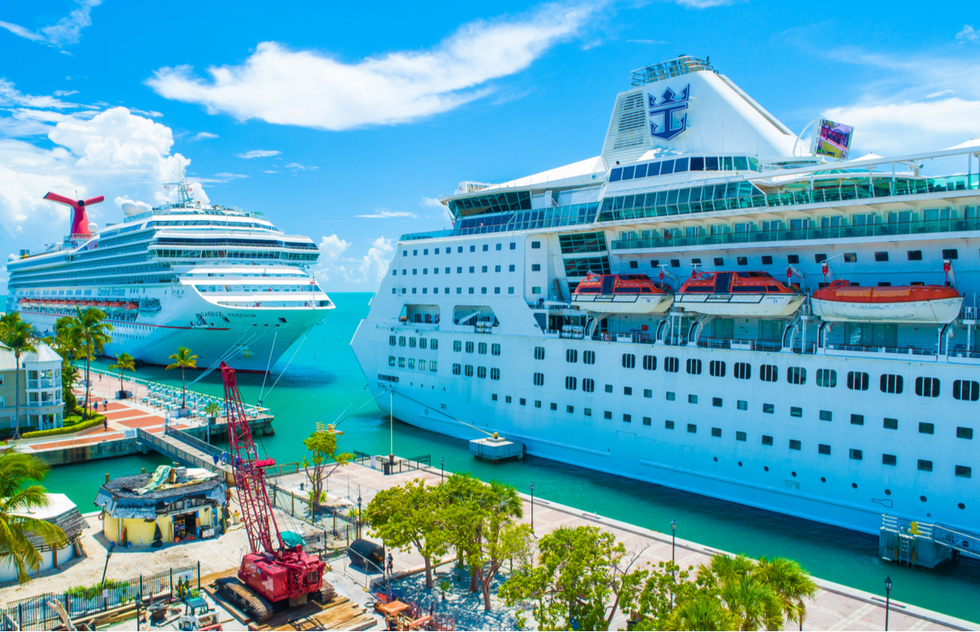Once a quiet fishing village and quirky haven for writers, artists, and free spirits, the Florida Straits city of Key West veered toward tourist-trap territory starting in the 1970s.
That's when cruise ships began arriving, intermittently at first, to disgorge their cargo of fun-seeking passengers. They would descend on the bars and souvenir stands near the dock for a few hours before heading back to the ship, leaving behind multitudes of emptied Rum Runner cups at Fat Tuesday or Sloppy Joe's.
Residents didn't get much say in the arrangement. Port authorities and cruise companies set (and, some would say, overstrained) capacity limits. The city even overhauled (and, some would say, ruined) the island's favorite sunset-watching spot, Mallory Square (pictured above), to accommodate large ships.
But earlier this year, in part as a response to Covid-19 flare-ups on cruises around the world, a group called the Key West Committee for Safer, Cleaner Ships successfully petitioned to get three initiatives on the ballot for Election Day that would ban mega ships from docking in Key West and limit the types of smaller ships allowed as well.
And this week, the locals finally got their revenge on the cruise companies.
Voters had three choices. They decided whether to limit the number of cruise passengers allowed to disembark to 1,500 per day, to cap the size of each visiting ship at 1,300 passengers apiece, and to prioritize ships with the "best environmental and health records." According to Florida's Monroe County Supervisor of Elections, all three measures passed, with 63%, 61%, and 81% of the vote, respectively.
The ban on ships that carry more than 1,300 passengers is probably the biggest blow to the cruise companies. As the Miami Herald reports, that excludes 40 of the 50 vessels that called on Key West in 2019, including the vast majority of mainstream ships belonging to major lines such as Norwegian Cruise Line, Disney Cruise Line, Royal Caribbean, and Carnival Cruise Line.
The new Virgin Voyages ship, still awaiting a first sailing delayed by the pandemic, is also out—it holds 3,900 passengers.
What does that leave? According to the Miami Herald's analysis, the 10 ships that docked in Key West last year that meet the new capacity criteria are all part of luxury cruise lines: Regent Seven Seas, Seabourn, Silversea, and Azamara.
So for passengers, it looks like less expensive cruises to Key West are suddenly hard to come by.
Outside of luxury lines, older ships tend to be smaller and charge lower fares than newer ones, but the new health and environmental standards might function to exclude those vessels as well. USA Today reports that each line will be assessed according to its record of government violations with regard to onboard sanitation and ecological impact. Older ships are less likely than new ones to have earth-friendly design features (hulls that maximize fuel efficiency, for instance), and Key West could deem those vessels insufficiently green even if they meet the new capacity limits.
In addition to having an impact on cruisers' budgets, the Key West measures will affect itineraries, too.
Cruise lines used to be able to add Key West to voyages at the last minute if they needed to avoid unexpected bad weather or civil unrest at a Caribbean port of call. Key West was a reliable stop because it's on American soil. Now, instead of seeing an extra port, passengers might have to spend extra days at sea or on a cruise company's private island—where the fun is tightly controlled and the prices are outrageous.
Another wrinkle from the perspective of cruise-goers: The Miami Herald report points out that luxury lines typically leave Florida and the Caribbean during the summer to visit cooler climes such as Alaska and the Mediterranean. Could that mean no cruise ships in Key West during the summer? Most of the people who live there evidently wouldn't mind—though some local business owners have mourned the loss of an estimated 12% in visitor spending on restaurants, retail, and recreation, even if most of that was collected by the town's biggest players located nearest the dock.
Right now, reps with the cruise companies and industry group Cruise Lines International Association are telling reporters that they hope to "open dialogue" with Key West and keep the city as a "travel partner."
But the industry will likely end up challenging the votes in court.
The changes in Key West go into effect immediately—not that it matters right now because U.S. cruises have been canceled till January 2021 at the earliest.
Though the Centers for Disease Control has lifted its eight-month no-sail order prompted by the pandemic, cruise companies still must prove their health and safety protocols work before they can hit the high seas again.






